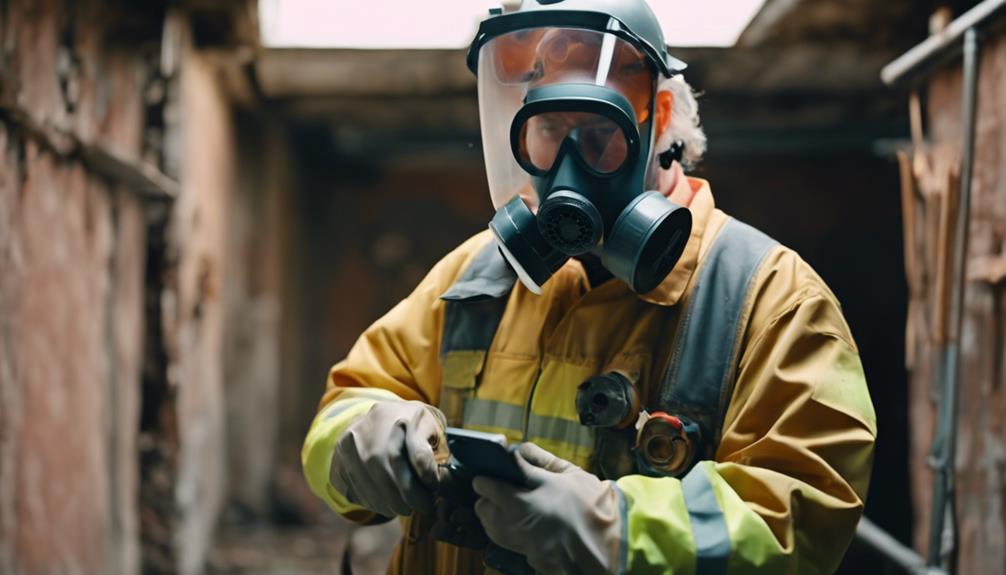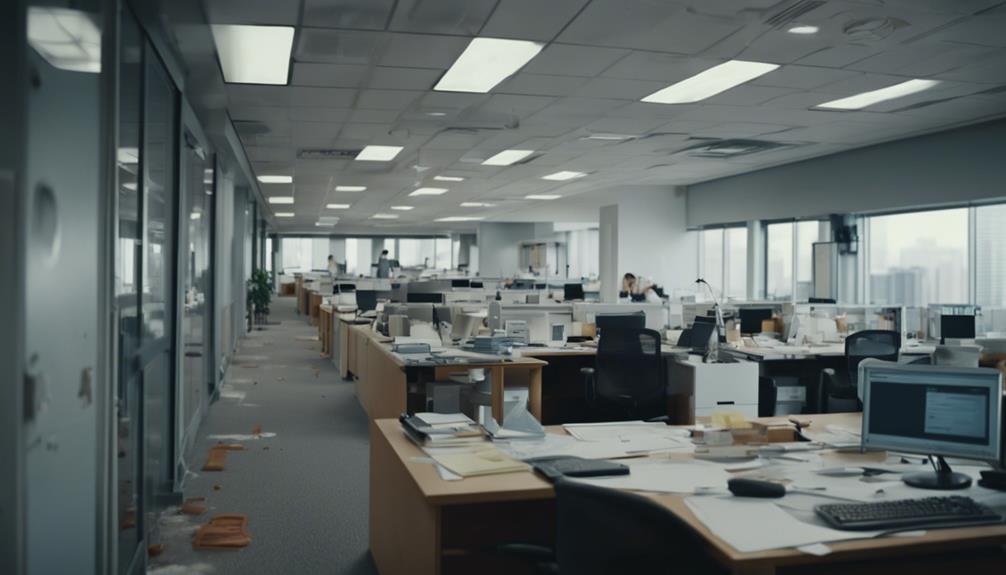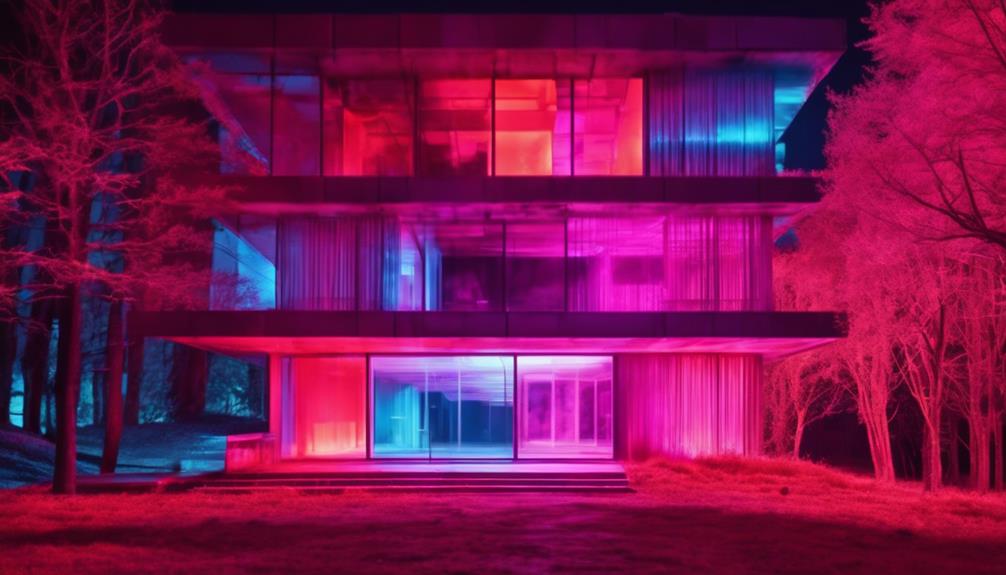Knowing about health risks in buildings is super important for staying healthy. Hidden dangers like bad air or pollution can hurt how you feel and think. Too much noise or really hot or cold temperatures can make you tired and hard to focus.
If buildings don't follow health and safety rules, there can be legal trouble. Routine check-ups can find secret problems like mold or unsafe stuff. Taking steps to prevent problems ensures your space is safe and comfy.
Try to learn from what others have done and stay updated with new methods to spot dangers. This way, you can handle and lower risks well. There's a lot more to understand about making spaces healthier.
Key Takeaways
- Checking for health dangers in buildings is like being a detective for safety. It helps keep people who use the building safe by reducing things that can cause harm, like polluted air.
- It also keeps building owners out of trouble because there are rules about making sure buildings are safe. If they don't follow these rules, they could end up having to pay money or go to court.
- Looking for hazards isn't just about physical safety, it's about comfort too. Things like too much noise, too little light, or the wrong temperature can all make people feel bad. So, it's important to control these factors.
- Technology can act like a superpower, helping to find hazards before they become a problem. It can warn about dangers so people can deal with them early.
- Studying what went wrong in other buildings can also help. By understanding past mistakes, we can make buildings safer in the future.
Understanding Health Hazards in Buildings
Buildings can have hidden health hazards. These include things like bad air quality, not enough fresh air, and too much pollution. These can cause health problems like difficulty breathing, allergies, and headaches.
But it's not only about the air. There's also noise, lighting, and extreme temperatures. These can be hard on your mind and body. They can make you uncomfortable and less productive. They can also lower the quality of your life.
But don't worry, there's a solution! We can check for these hazards and control them. Then, your space can be safe and comfortable. The goal is to make spaces that support good health, comfort, and productivity.
Legal Implications of Hazard Identification
Understanding the dangers in buildings is seriously important. If you ignore these dangers, you might get in big trouble with the law. This could mean paying fines or even being taken to court.
As someone who looks after buildings, you have to follow health and safety rules. It's not just a boring task, it's your job. Your buildings are more than just piles of bricks. They're places where people live, work, and make memories.
Finding dangers in buildings is more than just staying out of legal trouble. It's about keeping everyone safe. It's about making sure your building is a pleasant place to be in. It shows that you care about the health and safety of everyone who uses the building.
The Role of Building Inspections

Building inspections are really important. They help us find things that might be dangerous and not easily seen, like mold or unsafe materials.
These checks aren't just about making a list and checking it off. They help us find serious problems, like not enough fresh air or mold growing. This helps make sure the building is safe, healthy, and a good place for everyone inside.
Importance of Inspections
Building inspections are very important. They help us find things that could make us sick like bad air or mold in a building. If you work in Safety and Health, inspections are a key part of your job. They help you find dangers and fix them, making sure safety rules are followed.
Inspections act like our safety net, they help spot hidden dangers in our buildings. They help us stay safe. By doing inspections, we can find and fix problems quickly, keeping our buildings healthy. So, inspections are important, they're not just a normal part of the day – they're a way to keep us safe!
Together, we can work towards a safer, healthier future.
Uncovering Hidden Dangers
Getting Your House Checked
Ever wonder why we need to get our homes checked by experts? They are like super detectives, finding hidden dangers that we can't see, like invisible mold, asbestos, or poor air quality. Their job is to keep us safe and healthy.
But how do they find these hidden enemies?
| Hidden Enemy | How They Find It | How It Can Hurt Us |
|---|---|---|
| Mold | By Looking Carefully | Can Make Us Cough or Have Trouble Breathing |
| Asbestos | By Checking the Materials | Can Make Our Lungs Sick |
| Lead Paint | By Testing the Paint | Can Hurt Our Brains |
| Radon Gas | By Testing the Air | Can Cause Lung Cancer |
| Bad Air Quality | By Testing the Air | Can Make Us Allergic |
Always remember, these house checks are important. They keep us safe and make sure our homes are the best they can be.
Preventive Measures Against Health Hazards
To keep ourselves healthy while inside buildings, we need to do a few things. These actions will help us live healthier and happier lives.
First, we need to make sure our rooms have fresh air. We can do this by opening windows or using fans. This gets rid of bad stuff in the air and brings in clean air. It's also important to keep our rooms at the right temperature so we feel comfortable.
Second, we need to keep our buildings in good shape. This means fixing things when they break and cleaning often. This will make sure we don't get sick from bad air quality in our buildings.
Third, we need to have good lighting. This will make our rooms bright and help us feel better. It can also help us do our work better.
Fourth, we should keep our rooms quiet. Too much noise can make it hard to concentrate and can stress us out.
Finally, if we're working at a desk, we need to make sure our chairs and desks are comfy and good for our bodies. This will help us avoid body aches and pains.
These simple steps will help us stay healthy and happy while inside buildings. Start doing these today for a better tomorrow.
Impact on Workers Health and Well-being

Think about being in a place where the air, the things around you, and the pressure of the place might harm your health and happiness.
Picture how bad air inside, dangerous stuff your building is made of, and the stress of it all can affect your mental health.
Understanding these dangers is important because they can seriously change how well you work, how you feel, and in the end, your overall wellness.
Indoor Air Quality Effects
Think about this: You're in school, feeling tired and unable to concentrate. Worst of all, you've been getting headaches often. These signs might mean the air in your classroom isn't as clean as it should be.
This is a problem we don't always think about, but it's really important for our health. Things like dust, mold, and allergens can fill the air we breathe and the school's air systems may not be doing a good job cleaning it.
This isn't just about being comfortable; it's about staying healthy and doing your best in school. Bad indoor air can make it hard to breathe and mess with your thinking, which could affect how you do in school.
Hazards in Building Materials
We all know air quality in schools is a big deal, but it's just as crucial to think about the stuff used to build and take care of our buildings. This is super important for the people who work with these materials every day.
Some of these materials can be really harmful. For example, asbestos can really mess up your lungs, and lead can do bad things to your brain. Formaldehyde, which is often in glue, and VOCs, which are often in paint, can give you headaches and make it hard to breathe.
Mold can make allergies and asthma worse. Radon gas can sneak into our buildings and it can cause lung cancer. It's really important to find these harmful things and make our indoor air cleaner to keep our workers safe and healthy.
Mental Health Impacts
Unhealthy materials in buildings can hurt your body and your mind. Imagine being in a place where the air feels stuffy, the lights are too dim, or it's just too noisy. This can make you feel stressed, anxious, and less effective at your tasks.
The wrong kind of lighting and air can even make you feel tired, which affects your thinking. Too much noise can make you grumpy and distract you. It's not only about staying safe from physical harm, your mental health matters too. You have the right to be in places that help you feel good and do better, not the opposite.
Fixing these problems is very important. Remember, a healthy place to work is also a place where you can work best. Let's push for buildings that support our health, both body and mind.
Technological Advancements in Hazard Identification

Advanced tech tools like BIM, IoT sensors, and machine learning have changed the way we find and handle potential health dangers in our buildings. BIM lets us see and study possible risks before building starts. IoT sensors and smart devices keep an eye on air cleanliness, heat, and dampness, tracking any changes that could mean a health danger.
Machine learning uses this data to find patterns and odd things that could point to possible health risks. Quick processing of this info is important for keeping a safe place. Also, VR and AR applications have made training games more real and fun, helping us learn how to spot and handle health dangers better.
Thanks to mobile apps and software, we now have easy access to checklists for identifying hazards, reporting incidents, and other important tools. These changes encourage a hands-on approach to managing health risks in buildings.
| Technology | How it's used | Good stuff |
|---|---|---|
| BIM | Seeing possible risks | Can predict risks |
| IoT Sensors | Keeping an eye on the environment | Gives data in real time |
| Machine Learning | Spotting strange things | Warns early |
These tools make you feel like you're in charge of your building's health, giving you a sense of safety.
Case Studies of Effective Hazard Identification
Case studies are like success stories that show us how to spot health dangers in buildings. They can help us keep accidents from happening and make places safer. These studies aren't just ideas – they show us how things work in real life. They remind us that checking buildings carefully and involving workers in finding dangers is very important.
Let's look at an example about a tall building being built. The workers were part of the danger-finding process from the beginning. They spotted possible health risks early and stopped accidents from happening. This made sure they were safe. In another example, a regular check-up in a factory found hidden dangers. This led to quick action and stopped people from getting hurt.
These case studies can help us get better at finding dangers. They point us to how to manage risks well, and highlight how safety and health matter in all kinds of buildings. Keep in mind, you're not alone in doing this. Other people have done it before and their experiences can help you. If we use what they've learned, we can stop accidents, keep workers safe, and make our environment healthier and safer.
Conclusion
Identifying health dangers in buildings is really important. It's not just about following the law – it's about caring for people's health.
Regular checks, steps to stop problems before they start, and using new technology can make buildings safer. By looking at how others have successfully handled these issues, we can learn to spot hazards sooner.
Remember, when a building is healthy, so are you. Always keep an eye out and stay safe.


